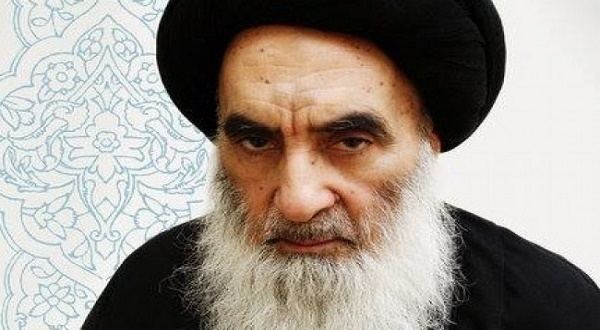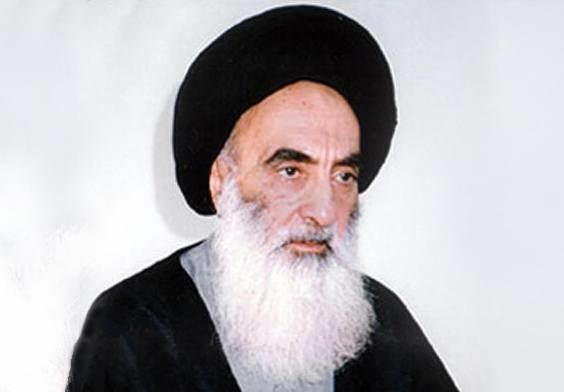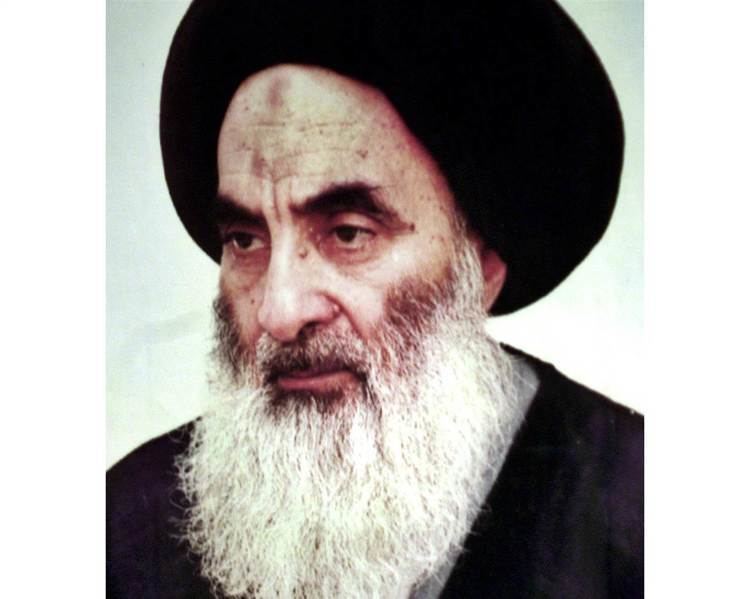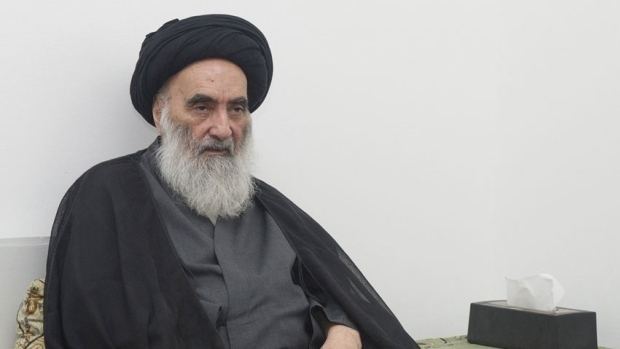Period in office 1992–Present Parents Sayyid Muhammad Baqir | Website www.sistani.org Name Ali al-Sistani | |
 | ||
Other names Arabic: علي الحسيني السيستانيPersian: علی حسینی سیستانی Born August 4, 1930 (age 95) Khorasan or Sistan, Iran ( 1930-08-04 ) Books Current Legal Issues, Contemporary Legal Rulings i, A Code of Practice for Muslims, Al‑Fiqh Lelmoghtarebeen, Almoyaser fi Al‑Hajj Wa AL‑O Similar People Muqtada al‑Sadr, Nouri al‑Maliki, Abu al‑Qasim al‑Khoei, Hossein Vahid Khorasani, Bassim Al‑Karbalaei | ||
Children Muhammad Rida al-Sistani | ||
Sistani object of emulation iraq
Al-Sayyid Ali al-Husseini al-Sistani (Arabic: السيد علي الحسيني السيستاني), or Sayyed Ali Hosseini Sistani (Persian: سید علی حسینی سیستانی), commonly known as Ayatollah Sistani in the Western world (born August 4, 1930), is an Shia marja in Iraq and the head of many of the seminaries (Hawzahs) in Najaf.
Contents
- Sistani object of emulation iraq
- Iraqi pm al maliki meeting grand ayatollah ali al sistani in najaf
- Early life
- Grand Ayatollah
- Baath Party
- Role in contemporary Iraq
- Fatwa for jihad against ISIS
- Shia patronage
- Ali al Sistanis Doctrine
- Al Jazeera
- Saudi cleric
- Nobel Peace Prize nomination
- Guardianship of Islamic Jurists wilayat al Faqih
- English
- Non English
- Internet
- Cyber attacks
- References

He is described as the spiritual leader of Iraqi Shia Muslims and one of the most senior clerics in Shia Islam.

Iraqi pm al maliki meeting grand ayatollah ali al sistani in najaf
Early life

Sistani was born in 1930 to a family of religious clerics; his father was Muhammad Baqir al-Sistani. Sistani himself claims to have been born in Mashhad, Iran, however there are disputes as to whether or not he was born in Mashhad or in Sistan and then moved to Mashhad as a child due to Iran not issuing birth certificates in its eastern provinces (now known as Region 5) until decades later.

Sistani began his religious education as a child, first in Mashhad in his father's hawzah, and continuing later in Qom. In 1951, Sistani traveled to Iraq to study in Najaf under Grand Ayatollah Abu al-Qasim al-Khoei. Sistani rose to the Usooli clerical rank of 'mujtahid' in 1960. At the unusually young age of thirty-one, Sistani reached the senior level of clerical accomplishment, or ijtihad, which entitled him to pass his own judgments on religious questions.

He has a son called Muhammad Rida al-Sistani.
Grand Ayatollah

When Grand Ayatollah Khoei died in 1992, Sistani ascended to the rank of Grand Ayatollah through traditional peer recognition of his scholarship. His role as successor to Khoei was symbolically cemented when he led funeral prayers for Khoei; he also inherited Khoei's network and following.
Ba'ath Party
During the years of Saddam Hussein's rule of Iraq through the Ba'ath Party, Sistani was untouched during the violent Ba'athist repression and persecution that killed many clerics including Mohammad Mohammad Sadeq al-Sadr in 1999, for which Saddam denied any involvement. His predecessor, Khoei, sat down with Saddam on state TV. After the death of Grand Ayatollah Khoei in 1992, Sistani emerged as the prominent Shia cleric to guide the Shia people under Saddam's rule, although Sistani's mosque was shut down in 1994 and did not reopen until the US-led 2003 invasion of Iraq.
Role in contemporary Iraq
Since the overthrow of the Ba'ath Party, Sistani has played an increasingly prominent role in regional religious and political affairs and he has been called the "most influential" figure in post-invasion Iraq.
Shortly after the US invasion began, Sistani issued a fatwa advising Shia clergy to become engaged in politics in order to better guide the Iraqi people toward "clearer decisions," and to fight "media propaganda." As the summer of 2003 approached, Sistani and his followers began to petition the occupying forces for a constitutional convention. Later, Sistani called for a democratic vote of the people for the purpose of forming a transitional government. Observers described the move as being a path leading directly to Shia political dominance over Iraq's government, as Shia Muslims make up approximately 60% of the total Iraqi population. Subsequently, Sistani criticized plans for an Iraqi government for not being democratic enough.
In early August, 2004, Sistani experienced serious health complications related to a previously diagnosed heart condition. He traveled to London to receive medical treatment. It was, reportedly, the first time that Sistani had left Iraq in decades, and may have been due, in part, to growing concerns for his safety from sectarian violence. Though still recovering, Sistani returned later in the month to broker a military truce at the Imam Ali Mosque in Najaf where Muqtada al-Sadr and the Mahdi Army had been cornered by American and Iraqi forces. Sadr, who rose rapidly to prominence through a series of independent military actions beginning in 2004, has since actively challenged Sistani's more progressive influence over Shia in the region.
Sistani's edicts reportedly provided many Iraqi Shia cause for participating in the January 2005 elections—he urged, in a statement on October 1, 2004, that Iraqis recognize the election as an "important matter," additionally, Sistani asked that the elections be "free and fair. . . with the participation of all Iraqis." Soon after, Sistani issued a fatwa alerting Shia women that they were religiously obligated to participate in the election, even if their husbands had forbidden them from voting. In an issued statement Sistani remarked that, "truly, women who go forth to the polling centers on election day are like Zaynab, who went forth to Karbala."
He has consistently urged the Iraqi Shia not to respond in kind to attacks from Sunni Salafists, which have become common in Sunni-dominated regions of Iraq like the area known as the "Triangle of Death," south of Baghdad. Even after the destruction of the Shia Al-Askari Mosque in Samarra in February 2006, his network of clerics and preachers continued to urge calm and told their followers that "it was not their Sunni neighbors who were killing them but foreign Wahhabis." Sistani's call for unity after the bombing of the mosque helped to control a potentially dangerous situation, preventing the country to enter in a bloody sectarian war. Sistani did the same when the same mosque was bombed again in 2007.
An alleged plot to assassinate Sistani was foiled on January 29, 2007, when three Jund al-Samaa gunmen were captured at a hotel near his office. It is believed to have been part of a larger attack against a number of targets in Najaf.
In an online open poll, 2005, Ali al-Sistani was selected as the 30th topmost intellectual person in the world on the list of Top 100 Public Intellectuals by Prospect Magazine (UK) and Foreign Policy (US).
On June 13, 2014 Sistani appealed that Iraqis should join the armed forces to fight terrorism exemplified by the Islamic State of Iraq and the Levant militant group which had taken over Mosul and Tikrit and was threatening Baghdad.
Fatwa for jihad against ISIS
In June 2014 Sistani issued a fatwa calling for "Citizens to defend the country, its people, the honor of its citizens, and its sacred places," against Islamic State of Iraq and the Levant group.
Shia patronage
As the leading Ayatollah in Najaf, Sistani oversees sums amounting to millions of US dollars. Sistani's followers offer him a fixed part of their earnings (tithe), which is used for educational and charitable purposes. Sistani's office has reported that it supports 35,000 students in Qom, 10,000 in Mashhad, and 4,000 in Isfahan. It also oversees a network of representatives (wakil) "who promote his (Sistani's) views in large and small ways in neighborhoods, mosques, bazaars, and seminaries from Kirkuk to Basra."
Additionally, Sistani has a substantial following within Shia communities all over the world and is the current Grand Marja of the Twelver sect of Shia Muslims. In Iran, as a result of the post-invasion opening of the Iraqi cities of Najaf and Karbala to Iranians, many Iranians are said to return from pilgrimage in Iraq as supporters of Sistani.
"Ali al-Sistani’s Doctrine"
An article entitled "Grand Ayatollah Ali al-Sistani’s Doctrine" reads "While Ayatollah Sistani remains mostly a recluse – a solitary man who seeks comfort and peace in the word of God, his shadow has stretch broad over Iraq, and his advice have echoed throughout. If many continue to measure their affluence and influence through their media visibility, Ayatollah Sistani needed no more than piety, and intelligence of the heart to reach millions". The article mentions Ali Sistani has placed "Marjaiat as a Civil Institution" and "Marjaiat – the Median of Government-Nation". His "Sensitivity to Corruption", "Sensitivity to Flattery and Formation of Biased Flow", "Avoiding over Politicization","Avoiding Exposure and Competition", "Supporting Human Rights and Freedom of other Religions", his "knowledge and wisdom" and his "Personal behaviour, ethics , honesty and modesty and moderation" has been recognised as the main source of his strength and power . That’s why, Grand Ayatollah Sistani gradually became the supreme Shia Marjaiat and the spiritual leader of the Iraqi people, without having any political authority. The article added "Grand Ayatollah Sistani’s power is not generated from traditional exposure, political and economic interference or any Mafia-like actions. He has done nothing to make himself a powerful person and is not competing with anyone. Although he does not have any military or political power, and even though he does not have access to funds his opinions have carried and shaped policies across not just Iraq but beyond. For the past 37 years Ayatollah Sistani has lived in the same modest rented house. Although he is well renowned his has no fortune to his name. A good listener and a curious mind still, Ayatollah Sistani epitomises good manners, and kindness of the heart."
Al Jazeera
In May 2007, hundreds of Shias demonstrated publicly in Basra and Najaf to protest comments made by television presenter and journalist Ahmed Mansour during a Qatari broadcast of Al Jazeera television programming. While presenting Bela Hodod (a.k.a. Without Borders), Mansour voiced skepticism of Sistani's leadership credentials while directing questions about the Iranian-born cleric to his guest, Shia cleric Jawad al-Khalsi. Mansour also suggested that Sistani was not aware of contemporary problems in Iraq or of prevailing post-war conditions, and he alleged that Sistani's edicts were, largely, written and disseminated by aides. At another point, Mansour asked Khalsi whether the United States was using Iraqi politicians, and also Sistani, to promote western interests in Iraq.
Saudi cleric
In January 2010, during a Jumu'ah khutba (Friday sermon), Saudi cleric Mohamad al-Arefe vehemently criticized Sistani by referring to him as an "atheist" and by describing his behavior as "debauched". The remarks prompted protest by his followers in Iraq, Qom and Lebanon. Iraqi Prime Minister Nouri al-Maliki rebuked the Saudi religious authorities. Lebanon-based Islamist militant organization Hezbollah also condemned the attack on Sistani, calling the speech "inauspicious," while praising Sistani as one of Shia Islam's "most prominent religious references."
Nobel Peace Prize nomination
On 4 March 2014, the Daily Telegraph commentator Colin Freeman published an article naming Ali al-Sistani as the most appropriate Nobel Peace Prize candidate. He also reported that he had been nominated earlier in 2006, by a group of Iraqi Christians.
On 8 March 2014, The Tehran Times reported that a group of members of Iraqi parliament announced that they intended to nominate Ali al-Sistani for the 2014 Nobel Peace Prize.
Thomas L. Friedman, former bureau chief of The New York Times in Beirut and Jerusalem (1982–88), nominated Ayatollah Sistani for the prize in 2005 and wrote the article titled “Nobel for Sistani” which was published in the Times on 20 March 2005.
Guardianship of Islamic Jurists (wilayat al Faqih)
Like his predecessor Abu al-Qasim al-Khoei, Sistani has not wholly embraced the post-Age-of-Occultation theory known as the Guardianship of the Islamic Jurists, which was espoused and supported by the late Iranian Grand Ayatollah Ruhollah Khomeini and which is currently extant and enforced by the Iranian government through its own constitution and by its supreme leader and highest religious authority Ayatollah Ali Khamenei. Sistani's scholarship regarding guardianship resembles Khoei's scholarship, but differs in several respects. Additionally, the primary difference between Sistani's interpretation and the interpretation of Grand Ayatollahs Khomeini and Khamenei is reportedly in the range of power that a Grand Ayatollah has in ruling the Islamic community. Sistani has publicly stated and maintained that his interpretation of doctrine is one that grants more power to the Ayatollahs than Khoei, but less than either Khoemeini or Khamenei:
Question: What is Grand Ayatollah Sistani's opinion about Velayat-e Faqih?
Answer: Every jurisprudent (Faqih) has wilayah (guardianship) over non-litigious affairs. Non-litigious affairs are called "al-omour al-hesbiah." As for general affairs to which social order is linked, and enforcement of doctrine, this depends on certain conditions, one of which is popularity of the Faqih among the majority of momeneen (believers).
On the specific question of obedience to a supreme leader, Sistani has said that any pronouncement given by a supreme leader "supersedes all, (including those given by other Maraji') unless the pronouncements are proven to be wrong or the pronouncements are proven to be against what is in the Qur'an or in Religious Tradition."
Additionally, instead of advocating for rule by Islamic clerics or for fundamentalist legal views, i.e. "the Quran as constitution," Sistani is said to favor a more relaxed perspective related to the provision of values and guidelines for social order (nizam al-mujama) as being the recognized, primary role of Islam.
Also, according to Sadegh Zibakalam, professor of political science at Tehran University, Sistani has consistently avoided supporting strict interpretation of the theory, especially of absolute guardianship, nor has he explicitly offered any substantive affirmation of the theory as a whole (including limited guardianship); thereby creating "a major lacuna" in the "grand ideological scenario" of the Islamic Republic of Iran.
According to scholar Vali Nasr, despite Sistani's disagreements with Iran's ruling clerics, he has "never tried to promote a rivalry" between his religious center of Najaf and the Iranian center in Qom, and has never made any comments about the confrontations between reformists and conservatives in Qom or between clerics in Lebanon, a reflection, Nasr believes, of Sistani's reluctance to become involved in politics.
English
Non-English
His office states that thirty two other works exist, but have not been translated into English.
Internet
By working with Shia computer programmers and other specialists, Sistani sponsored the establishment of The Aalulbayt (a.s.) Global Information Center, an international web-resource, and he has since been called "the electronic grand ayatollah par excellence."
Cyber attacks
On September 18, 2008, hackers attacked hundreds of Shia websites. The attacks reportedly were the work of group-xp, a Muslim faction based in the United Arab Emirates which is linked to Salafi and Wahhabi, strict forms of Islam. They attacked an estimated three hundred Shia internet websites including The Aalulbayt (a.s.) Global Information Center. It was later dubbed the "largest Wahhabi hacker attack" in recent years.
After the attack, visitors to the site were greeted by a red attack banner bearing the slogan "group-xp" paired with a message in Arabic denouncing Shia beliefs and officials. Hackers also replaced a video of Sistani with one of comedian Bill Maher mocking Sistani.
However, the attack led to the retaliatory hacking of more than nine hundred Wahhabi and Salafi websites. One such successful attack was documented on video and uploaded to YouTube on October 3, 2008. The hacker, a Shia from the United Arab Emirates using the handle "ShiaZone," was shown logging into email accounts of suspected members of group-xp. The hacked email accounts reportedly yielded group-xp's contact information, information that was subsequently posted on Shia websites.
